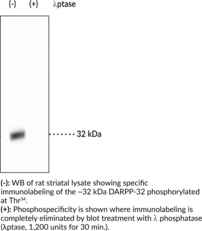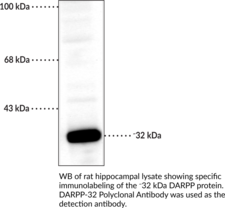Cayman
Showing 17401–17550 of 45550 results
-
DAPH is a phthalimide with diverse biological activities.{47738,47739,47740,47741} It is an EGFR inhibitor that selectively inhibits the EGFR intracellular kinase domain over v-Abl, c-Src, PKCα, PKCβ1, PKCβ2, and PKCγ (IC50s = 0.3, >50, 16, 6, 30, 4.8, and 30 μM, respectively) and a panel of 11 other kinases.{47738} It also inhibits EGFR autophosphorylation in A431 human epidermoid carcinoma cell membranes and intact cells (IC50s = 1 and 17205) in isolated rat endothelium-denuded aortic rings in a concentration-dependent manner.{47739} It inhibits aggregation of amyloid-β (1-42) (Aβ42) peptide (Item No. 20574), disaggregates preformed Aβ42 fibrils, and inhibits calcium influx into mouse CATH.a neuronal cells when used at a concentration of 10 μM.{47740} DAPH also inhibits aggregation of a Sup35 yeast prion protein fragment that contains its N-terminal and highly charged middle domains (IC50 = 0.58 μM).{47741}
Brand:CaymanSKU:29196 - 1 mgAvailable on backorder
DAPH is a phthalimide with diverse biological activities.{47738,47739,47740,47741} It is an EGFR inhibitor that selectively inhibits the EGFR intracellular kinase domain over v-Abl, c-Src, PKCα, PKCβ1, PKCβ2, and PKCγ (IC50s = 0.3, >50, 16, 6, 30, 4.8, and 30 μM, respectively) and a panel of 11 other kinases.{47738} It also inhibits EGFR autophosphorylation in A431 human epidermoid carcinoma cell membranes and intact cells (IC50s = 1 and 17205) in isolated rat endothelium-denuded aortic rings in a concentration-dependent manner.{47739} It inhibits aggregation of amyloid-β (1-42) (Aβ42) peptide (Item No. 20574), disaggregates preformed Aβ42 fibrils, and inhibits calcium influx into mouse CATH.a neuronal cells when used at a concentration of 10 μM.{47740} DAPH also inhibits aggregation of a Sup35 yeast prion protein fragment that contains its N-terminal and highly charged middle domains (IC50 = 0.58 μM).{47741}
Brand:CaymanSKU:29196 - 10 mgAvailable on backorder
DAPH is a phthalimide with diverse biological activities.{47738,47739,47740,47741} It is an EGFR inhibitor that selectively inhibits the EGFR intracellular kinase domain over v-Abl, c-Src, PKCα, PKCβ1, PKCβ2, and PKCγ (IC50s = 0.3, >50, 16, 6, 30, 4.8, and 30 μM, respectively) and a panel of 11 other kinases.{47738} It also inhibits EGFR autophosphorylation in A431 human epidermoid carcinoma cell membranes and intact cells (IC50s = 1 and 17205) in isolated rat endothelium-denuded aortic rings in a concentration-dependent manner.{47739} It inhibits aggregation of amyloid-β (1-42) (Aβ42) peptide (Item No. 20574), disaggregates preformed Aβ42 fibrils, and inhibits calcium influx into mouse CATH.a neuronal cells when used at a concentration of 10 μM.{47740} DAPH also inhibits aggregation of a Sup35 yeast prion protein fragment that contains its N-terminal and highly charged middle domains (IC50 = 0.58 μM).{47741}
Brand:CaymanSKU:29196 - 25 mgAvailable on backorder
DAPH is a phthalimide with diverse biological activities.{47738,47739,47740,47741} It is an EGFR inhibitor that selectively inhibits the EGFR intracellular kinase domain over v-Abl, c-Src, PKCα, PKCβ1, PKCβ2, and PKCγ (IC50s = 0.3, >50, 16, 6, 30, 4.8, and 30 μM, respectively) and a panel of 11 other kinases.{47738} It also inhibits EGFR autophosphorylation in A431 human epidermoid carcinoma cell membranes and intact cells (IC50s = 1 and 17205) in isolated rat endothelium-denuded aortic rings in a concentration-dependent manner.{47739} It inhibits aggregation of amyloid-β (1-42) (Aβ42) peptide (Item No. 20574), disaggregates preformed Aβ42 fibrils, and inhibits calcium influx into mouse CATH.a neuronal cells when used at a concentration of 10 μM.{47740} DAPH also inhibits aggregation of a Sup35 yeast prion protein fragment that contains its N-terminal and highly charged middle domains (IC50 = 0.58 μM).{47741}
Brand:CaymanSKU:29196 - 5 mgAvailable on backorder
Daphnetin is a coumarin derivative that has been isolated from plants of the genus Daphne and has diverse biological activities, including kinase inhibitory, anti-proliferative, and antioxidative properties.{47032,47033,47034} It inhibits the EGF receptor (EGFR), PKA, and PKC (IC50s = 7.67, 9.33, and 25.01 µM, respectively, in kinase assays) and inhibits cell proliferation (IC50 = 73 µM) and reduces cyclin D1 levels in MCF-7 breast carcinoma cells.{47032,47033} Daphnetin (5 and 10 µg/ml) decreases the generation of reactive oxygen species (ROS) and production of malondialdehyde (MDA) and increases superoxide dismutase (SOD) activity and the glutathione (GSH) to oxidized GSH (GSSG) ratio in RAW 264.7 cells.{47034} It also prevents cytotoxicity and ROS overproduction induced by t-butyl hydroperoxide (t-BHP) in wild-type, but not Nrf2-/-, RAW 264.7 cells and increases the expression of proteins downstream of Nrf2, including HO-1, GCLM, GCLC, and NQO1.
Brand:CaymanSKU:20826 -Out of stock
Daphnetin is a coumarin derivative that has been isolated from plants of the genus Daphne and has diverse biological activities, including kinase inhibitory, anti-proliferative, and antioxidative properties.{47032,47033,47034} It inhibits the EGF receptor (EGFR), PKA, and PKC (IC50s = 7.67, 9.33, and 25.01 µM, respectively, in kinase assays) and inhibits cell proliferation (IC50 = 73 µM) and reduces cyclin D1 levels in MCF-7 breast carcinoma cells.{47032,47033} Daphnetin (5 and 10 µg/ml) decreases the generation of reactive oxygen species (ROS) and production of malondialdehyde (MDA) and increases superoxide dismutase (SOD) activity and the glutathione (GSH) to oxidized GSH (GSSG) ratio in RAW 264.7 cells.{47034} It also prevents cytotoxicity and ROS overproduction induced by t-butyl hydroperoxide (t-BHP) in wild-type, but not Nrf2-/-, RAW 264.7 cells and increases the expression of proteins downstream of Nrf2, including HO-1, GCLM, GCLC, and NQO1.
Brand:CaymanSKU:20826 -Out of stock
Daphnetin is a coumarin derivative that has been isolated from plants of the genus Daphne and has diverse biological activities, including kinase inhibitory, anti-proliferative, and antioxidative properties.{47032,47033,47034} It inhibits the EGF receptor (EGFR), PKA, and PKC (IC50s = 7.67, 9.33, and 25.01 µM, respectively, in kinase assays) and inhibits cell proliferation (IC50 = 73 µM) and reduces cyclin D1 levels in MCF-7 breast carcinoma cells.{47032,47033} Daphnetin (5 and 10 µg/ml) decreases the generation of reactive oxygen species (ROS) and production of malondialdehyde (MDA) and increases superoxide dismutase (SOD) activity and the glutathione (GSH) to oxidized GSH (GSSG) ratio in RAW 264.7 cells.{47034} It also prevents cytotoxicity and ROS overproduction induced by t-butyl hydroperoxide (t-BHP) in wild-type, but not Nrf2-/-, RAW 264.7 cells and increases the expression of proteins downstream of Nrf2, including HO-1, GCLM, GCLC, and NQO1.
Brand:CaymanSKU:20826 -Out of stock
Daphnetin is a coumarin derivative that has been isolated from plants of the genus Daphne and has diverse biological activities, including kinase inhibitory, anti-proliferative, and antioxidative properties.{47032,47033,47034} It inhibits the EGF receptor (EGFR), PKA, and PKC (IC50s = 7.67, 9.33, and 25.01 µM, respectively, in kinase assays) and inhibits cell proliferation (IC50 = 73 µM) and reduces cyclin D1 levels in MCF-7 breast carcinoma cells.{47032,47033} Daphnetin (5 and 10 µg/ml) decreases the generation of reactive oxygen species (ROS) and production of malondialdehyde (MDA) and increases superoxide dismutase (SOD) activity and the glutathione (GSH) to oxidized GSH (GSSG) ratio in RAW 264.7 cells.{47034} It also prevents cytotoxicity and ROS overproduction induced by t-butyl hydroperoxide (t-BHP) in wild-type, but not Nrf2-/-, RAW 264.7 cells and increases the expression of proteins downstream of Nrf2, including HO-1, GCLM, GCLC, and NQO1.
Brand:CaymanSKU:20826 -Out of stock
Daphnoretin is a coumarin that has been found in W. indica and has diverse biological activities.{48370,48371,48372} It induces aggregation of washed rabbit platelets (EC50 = 17.2 μM), an effect that is reversed by the protein kinase C (PKC) inhibitor staurosporine (Item No. 81590).{48370} Daphnoretin is active against respiratory syncytial virus (RSV) in a plaque reduction assay using HEp-2 cells (IC50 = 5.87 μg/ml).{48371} It halts the cell cycle at the G2/M phase, induces apoptosis, and inhibits proliferation of human osteosarcoma (HOS) cells (IC50 = 3.89 μM).{48372} Daphnoretin also reduces proliferation, invasion, and migration of HCT116 colon cancer cells in a concentration-dependent manner.{48373}
Brand:CaymanSKU:26408 - 1 mgAvailable on backorder
Daphnoretin is a coumarin that has been found in W. indica and has diverse biological activities.{48370,48371,48372} It induces aggregation of washed rabbit platelets (EC50 = 17.2 μM), an effect that is reversed by the protein kinase C (PKC) inhibitor staurosporine (Item No. 81590).{48370} Daphnoretin is active against respiratory syncytial virus (RSV) in a plaque reduction assay using HEp-2 cells (IC50 = 5.87 μg/ml).{48371} It halts the cell cycle at the G2/M phase, induces apoptosis, and inhibits proliferation of human osteosarcoma (HOS) cells (IC50 = 3.89 μM).{48372} Daphnoretin also reduces proliferation, invasion, and migration of HCT116 colon cancer cells in a concentration-dependent manner.{48373}
Brand:CaymanSKU:26408 - 10 mgAvailable on backorder
Daphnoretin is a coumarin that has been found in W. indica and has diverse biological activities.{48370,48371,48372} It induces aggregation of washed rabbit platelets (EC50 = 17.2 μM), an effect that is reversed by the protein kinase C (PKC) inhibitor staurosporine (Item No. 81590).{48370} Daphnoretin is active against respiratory syncytial virus (RSV) in a plaque reduction assay using HEp-2 cells (IC50 = 5.87 μg/ml).{48371} It halts the cell cycle at the G2/M phase, induces apoptosis, and inhibits proliferation of human osteosarcoma (HOS) cells (IC50 = 3.89 μM).{48372} Daphnoretin also reduces proliferation, invasion, and migration of HCT116 colon cancer cells in a concentration-dependent manner.{48373}
Brand:CaymanSKU:26408 - 25 mgAvailable on backorder
Daphnoretin is a coumarin that has been found in W. indica and has diverse biological activities.{48370,48371,48372} It induces aggregation of washed rabbit platelets (EC50 = 17.2 μM), an effect that is reversed by the protein kinase C (PKC) inhibitor staurosporine (Item No. 81590).{48370} Daphnoretin is active against respiratory syncytial virus (RSV) in a plaque reduction assay using HEp-2 cells (IC50 = 5.87 μg/ml).{48371} It halts the cell cycle at the G2/M phase, induces apoptosis, and inhibits proliferation of human osteosarcoma (HOS) cells (IC50 = 3.89 μM).{48372} Daphnoretin also reduces proliferation, invasion, and migration of HCT116 colon cancer cells in a concentration-dependent manner.{48373}
Brand:CaymanSKU:26408 - 5 mgAvailable on backorder
DAPI is a fluorescent probe which is commonly used to stain DNA and chromosomes for fluorescent microscopy and flow cytometry applications.{22440,22441} It forms a fluorescent complex by attaching in the minor groove of A-T rich sequences of DNA.{22440} DAPI is often used as a counterstain, as its ultraviolet (max 358 nm) excitation and blue (max 461 nm) emission wavelengths separate it nicely from many popular primary fluorophores. It can be used on either fixed or live cells, although its low permeability in live cells demands that higher concentrations be used.{22441}
Brand:CaymanSKU:-DAPI is a fluorescent probe which is commonly used to stain DNA and chromosomes for fluorescent microscopy and flow cytometry applications.{22440,22441} It forms a fluorescent complex by attaching in the minor groove of A-T rich sequences of DNA.{22440} DAPI is often used as a counterstain, as its ultraviolet (max 358 nm) excitation and blue (max 461 nm) emission wavelengths separate it nicely from many popular primary fluorophores. It can be used on either fixed or live cells, although its low permeability in live cells demands that higher concentrations be used.{22441}
Brand:CaymanSKU:-DAPI is a fluorescent probe which is commonly used to stain DNA and chromosomes for fluorescent microscopy and flow cytometry applications.{22440,22441} It forms a fluorescent complex by attaching in the minor groove of A-T rich sequences of DNA.{22440} DAPI is often used as a counterstain, as its ultraviolet (max 358 nm) excitation and blue (max 461 nm) emission wavelengths separate it nicely from many popular primary fluorophores. It can be used on either fixed or live cells, although its low permeability in live cells demands that higher concentrations be used.{22441}
Brand:CaymanSKU:-Dapiprazole is an α-adrenergic receptor (α-AR) antagonist.{48750} It inhibits norepinephrine-induced contractions in rat vas deferens, guinea pig spleen, and rat aorta, regions that express high levels of α1A-AR, α1B-AR, and α1D-ARs, respectively (pA2s = 7.93, 7.13, and 8.26, respectively). It also inhibits contractions induced by histamine, angiotensin II, pentagastrin (Item No. 28546), carbamoylcholine (carbachol; Item No. 14486), and serotonin (Item No. 14332) in guinea pig ileum in a dose-dependent manner.{48751} Dapiprazole (0.05%, intracameral) reverses pupil dilation induced by a combination of the α1A-AR agonist phenylephrine and the muscarinic M4 antagonist tropicamide (Item No. 16606) in rabbits.{48752} Formulations containing dapiprazole have been used in the treatment of iatrogenically induced mydriasis by adrenergic or parasympatholytic agents in certain eye examinations.
Brand:CaymanSKU:29222 - 10 mgAvailable on backorder
Dapiprazole is an α-adrenergic receptor (α-AR) antagonist.{48750} It inhibits norepinephrine-induced contractions in rat vas deferens, guinea pig spleen, and rat aorta, regions that express high levels of α1A-AR, α1B-AR, and α1D-ARs, respectively (pA2s = 7.93, 7.13, and 8.26, respectively). It also inhibits contractions induced by histamine, angiotensin II, pentagastrin (Item No. 28546), carbamoylcholine (carbachol; Item No. 14486), and serotonin (Item No. 14332) in guinea pig ileum in a dose-dependent manner.{48751} Dapiprazole (0.05%, intracameral) reverses pupil dilation induced by a combination of the α1A-AR agonist phenylephrine and the muscarinic M4 antagonist tropicamide (Item No. 16606) in rabbits.{48752} Formulations containing dapiprazole have been used in the treatment of iatrogenically induced mydriasis by adrenergic or parasympatholytic agents in certain eye examinations.
Brand:CaymanSKU:29222 - 100 mgAvailable on backorder
Dapiprazole is an α-adrenergic receptor (α-AR) antagonist.{48750} It inhibits norepinephrine-induced contractions in rat vas deferens, guinea pig spleen, and rat aorta, regions that express high levels of α1A-AR, α1B-AR, and α1D-ARs, respectively (pA2s = 7.93, 7.13, and 8.26, respectively). It also inhibits contractions induced by histamine, angiotensin II, pentagastrin (Item No. 28546), carbamoylcholine (carbachol; Item No. 14486), and serotonin (Item No. 14332) in guinea pig ileum in a dose-dependent manner.{48751} Dapiprazole (0.05%, intracameral) reverses pupil dilation induced by a combination of the α1A-AR agonist phenylephrine and the muscarinic M4 antagonist tropicamide (Item No. 16606) in rabbits.{48752} Formulations containing dapiprazole have been used in the treatment of iatrogenically induced mydriasis by adrenergic or parasympatholytic agents in certain eye examinations.
Brand:CaymanSKU:29222 - 250 mgAvailable on backorder
Dapiprazole is an α-adrenergic receptor (α-AR) antagonist.{48750} It inhibits norepinephrine-induced contractions in rat vas deferens, guinea pig spleen, and rat aorta, regions that express high levels of α1A-AR, α1B-AR, and α1D-ARs, respectively (pA2s = 7.93, 7.13, and 8.26, respectively). It also inhibits contractions induced by histamine, angiotensin II, pentagastrin (Item No. 28546), carbamoylcholine (carbachol; Item No. 14486), and serotonin (Item No. 14332) in guinea pig ileum in a dose-dependent manner.{48751} Dapiprazole (0.05%, intracameral) reverses pupil dilation induced by a combination of the α1A-AR agonist phenylephrine and the muscarinic M4 antagonist tropicamide (Item No. 16606) in rabbits.{48752} Formulations containing dapiprazole have been used in the treatment of iatrogenically induced mydriasis by adrenergic or parasympatholytic agents in certain eye examinations.
Brand:CaymanSKU:29222 - 50 mgAvailable on backorder
Non-nucleoside reverse transcriptase inhibitors (NNRTIs) are highly specific and potent allosteric inhibitors of HIV-1 reverse transcriptase. Dapivirine, a diarylpyrimidine derivative of the potent NNRTI efavirenz (Item No. 14412), inhibits HIV-1 reverse transcriptase with an IC50 value of 24 nM in vitro.{29624} It impedes the late stages of HIV-1 infection by interfering with HIV-1 Gag-Pol polyprotein processing.{22818}
Brand:CaymanSKU:-Non-nucleoside reverse transcriptase inhibitors (NNRTIs) are highly specific and potent allosteric inhibitors of HIV-1 reverse transcriptase. Dapivirine, a diarylpyrimidine derivative of the potent NNRTI efavirenz (Item No. 14412), inhibits HIV-1 reverse transcriptase with an IC50 value of 24 nM in vitro.{29624} It impedes the late stages of HIV-1 infection by interfering with HIV-1 Gag-Pol polyprotein processing.{22818}
Brand:CaymanSKU:-Non-nucleoside reverse transcriptase inhibitors (NNRTIs) are highly specific and potent allosteric inhibitors of HIV-1 reverse transcriptase. Dapivirine, a diarylpyrimidine derivative of the potent NNRTI efavirenz (Item No. 14412), inhibits HIV-1 reverse transcriptase with an IC50 value of 24 nM in vitro.{29624} It impedes the late stages of HIV-1 infection by interfering with HIV-1 Gag-Pol polyprotein processing.{22818}
Brand:CaymanSKU:-Non-nucleoside reverse transcriptase inhibitors (NNRTIs) are highly specific and potent allosteric inhibitors of HIV-1 reverse transcriptase. Dapivirine, a diarylpyrimidine derivative of the potent NNRTI efavirenz (Item No. 14412), inhibits HIV-1 reverse transcriptase with an IC50 value of 24 nM in vitro.{29624} It impedes the late stages of HIV-1 infection by interfering with HIV-1 Gag-Pol polyprotein processing.{22818}
Brand:CaymanSKU:-Dapoxetine (hydrochloride) (Item No. 9002488) is an analytical reference standard that is categorized as a selective serotonin reuptake inhibitor.{30484} It provides improvement in several parameters related to premature ejaculation in clinical trials.{30483} This product is intended for research and forensic applications.
Brand:CaymanSKU:9002488 - 1 mgAvailable on backorder
Dapoxetine (hydrochloride) (Item No. 9002488) is an analytical reference standard that is categorized as a selective serotonin reuptake inhibitor.{30484} It provides improvement in several parameters related to premature ejaculation in clinical trials.{30483} This product is intended for research and forensic applications.
Brand:CaymanSKU:9002488 - 5 mgAvailable on backorder
Dapoxetine (hydrochloride) (Item No. 9002488) is an analytical reference standard that is categorized as a selective serotonin reuptake inhibitor.{30484} It provides improvement in several parameters related to premature ejaculation in clinical trials.{30483} This product is intended for research and forensic applications.
Brand:CaymanSKU:9002488 - 50 mgAvailable on backorder
Daprodustat is an inhibitor of hypoxia-inducible factor (HIF) prolyl hydroxylase that increases HIF stability and action. It is orally bioavailable, induces an effective erythropoietin (EPO) response, and stimulates non-EPO mechanisms of erythropoiesis in animal models. Daprodustat and related HIF prolyl hydroxylase inhibitors are in clinical trials for the treatment of anemia associated with chronic kidney disease.{31861,31862}
Brand:CaymanSKU:19915 -Available on backorder
Daprodustat is an inhibitor of hypoxia-inducible factor (HIF) prolyl hydroxylase that increases HIF stability and action. It is orally bioavailable, induces an effective erythropoietin (EPO) response, and stimulates non-EPO mechanisms of erythropoiesis in animal models. Daprodustat and related HIF prolyl hydroxylase inhibitors are in clinical trials for the treatment of anemia associated with chronic kidney disease.{31861,31862}
Brand:CaymanSKU:19915 -Available on backorder
Daprodustat is an inhibitor of hypoxia-inducible factor (HIF) prolyl hydroxylase that increases HIF stability and action. It is orally bioavailable, induces an effective erythropoietin (EPO) response, and stimulates non-EPO mechanisms of erythropoiesis in animal models. Daprodustat and related HIF prolyl hydroxylase inhibitors are in clinical trials for the treatment of anemia associated with chronic kidney disease.{31861,31862}
Brand:CaymanSKU:19915 -Available on backorder
Daprodustat is an inhibitor of hypoxia-inducible factor (HIF) prolyl hydroxylase that increases HIF stability and action. It is orally bioavailable, induces an effective erythropoietin (EPO) response, and stimulates non-EPO mechanisms of erythropoiesis in animal models. Daprodustat and related HIF prolyl hydroxylase inhibitors are in clinical trials for the treatment of anemia associated with chronic kidney disease.{31861,31862}
Brand:CaymanSKU:19915 -Available on backorder
Dapsone is an anti-inflammatory, antimalarial, and antibacterial compound.{28213} In vivo, dapsone (34 μg/animal per day) reduces epidermal hyperproliferation and epithelial thickness in the esophagus in a mouse model of proliferative dermatitis.{38501} It reduces lipid peroxidation, myeloperoxidase activity, and cellular apoptosis in the striatum of rats following ischemia and reperfusion injury.{38502} Dapsone reduces growth of M. leprae in the footpad of mice (MIC = 0.01-0.03 μg/ml in sera) and induces clearance of P. knowlesi infections in macaques.{38503,38504} It also reduces the number of P. gallinaceum sporozoites in a mosquito population allowed to feed on dapsone-treated chicks.{38504} Formulations containing dapsone have been used in the treatment of malaria, acne, dermatitis, and leprosy.
Brand:CaymanSKU:23743 - 100 gAvailable on backorder
Dapsone is an anti-inflammatory, antimalarial, and antibacterial compound.{28213} In vivo, dapsone (34 μg/animal per day) reduces epidermal hyperproliferation and epithelial thickness in the esophagus in a mouse model of proliferative dermatitis.{38501} It reduces lipid peroxidation, myeloperoxidase activity, and cellular apoptosis in the striatum of rats following ischemia and reperfusion injury.{38502} Dapsone reduces growth of M. leprae in the footpad of mice (MIC = 0.01-0.03 μg/ml in sera) and induces clearance of P. knowlesi infections in macaques.{38503,38504} It also reduces the number of P. gallinaceum sporozoites in a mosquito population allowed to feed on dapsone-treated chicks.{38504} Formulations containing dapsone have been used in the treatment of malaria, acne, dermatitis, and leprosy.
Brand:CaymanSKU:23743 - 50 gAvailable on backorder
Dapsone-d8 is intended for use as an internal standard for the quantification of dapsone by GC- or LC-MS. Dapsone is an anti-inflammatory and antibacterial compound that is widely used in the treatment of leprosy, malaria, acne, and various immune disorders.{28213} Dapsone is acetylated in the liver to monoacetyldapsone, the major metabolite, and other mono and diacetyl derivatives, and subsequently deacetylated back to diaminodiphenylsulfone (dapsone) until a state of equilibrium is achieved.
Brand:CaymanSKU:22113 -Out of stock
Dapsone-d8 is intended for use as an internal standard for the quantification of dapsone by GC- or LC-MS. Dapsone is an anti-inflammatory and antibacterial compound that is widely used in the treatment of leprosy, malaria, acne, and various immune disorders.{28213} Dapsone is acetylated in the liver to monoacetyldapsone, the major metabolite, and other mono and diacetyl derivatives, and subsequently deacetylated back to diaminodiphenylsulfone (dapsone) until a state of equilibrium is achieved.
Brand:CaymanSKU:22113 -Out of stock
γ-Secretase is a multi-subunit aspartyl protease that cleaves amyloid precursor protein (APP) and many other type 1 transmembrane proteins, including Notch, E-cadherin, and ErbB4. The proteolysis of APP by secretases produces beta amyloid (Aβ), a 39- to 42-amino acid peptide which forms the amyloid plaques that are characteristic of Alzheimer’s disease. DAPT is an inhibitor of γ-secretase, blocking the production of total Aβ in human primary neuronal cultures with an IC50 value of 115 nM and Aβ42 with an IC50 value of 200 nM.{18537} DAPT is also effective in vivo, reducing brain levels of Aβ when given orally to mice that are transgenic for human APPV717F or to rats.{18537,18534,18535} Through its effects on γ-secretase, DAPT indirectly inhibits Notch, affecting cell signaling and cell differentiation.{18536,18538}
Brand:CaymanSKU:-γ-Secretase is a multi-subunit aspartyl protease that cleaves amyloid precursor protein (APP) and many other type 1 transmembrane proteins, including Notch, E-cadherin, and ErbB4. The proteolysis of APP by secretases produces beta amyloid (Aβ), a 39- to 42-amino acid peptide which forms the amyloid plaques that are characteristic of Alzheimer’s disease. DAPT is an inhibitor of γ-secretase, blocking the production of total Aβ in human primary neuronal cultures with an IC50 value of 115 nM and Aβ42 with an IC50 value of 200 nM.{18537} DAPT is also effective in vivo, reducing brain levels of Aβ when given orally to mice that are transgenic for human APPV717F or to rats.{18537,18534,18535} Through its effects on γ-secretase, DAPT indirectly inhibits Notch, affecting cell signaling and cell differentiation.{18536,18538}
Brand:CaymanSKU:-γ-Secretase is a multi-subunit aspartyl protease that cleaves amyloid precursor protein (APP) and many other type 1 transmembrane proteins, including Notch, E-cadherin, and ErbB4. The proteolysis of APP by secretases produces beta amyloid (Aβ), a 39- to 42-amino acid peptide which forms the amyloid plaques that are characteristic of Alzheimer’s disease. DAPT is an inhibitor of γ-secretase, blocking the production of total Aβ in human primary neuronal cultures with an IC50 value of 115 nM and Aβ42 with an IC50 value of 200 nM.{18537} DAPT is also effective in vivo, reducing brain levels of Aβ when given orally to mice that are transgenic for human APPV717F or to rats.{18537,18534,18535} Through its effects on γ-secretase, DAPT indirectly inhibits Notch, affecting cell signaling and cell differentiation.{18536,18538}
Brand:CaymanSKU:-γ-Secretase is a multi-subunit aspartyl protease that cleaves amyloid precursor protein (APP) and many other type 1 transmembrane proteins, including Notch, E-cadherin, and ErbB4. The proteolysis of APP by secretases produces beta amyloid (Aβ), a 39- to 42-amino acid peptide which forms the amyloid plaques that are characteristic of Alzheimer’s disease. DAPT is an inhibitor of γ-secretase, blocking the production of total Aβ in human primary neuronal cultures with an IC50 value of 115 nM and Aβ42 with an IC50 value of 200 nM.{18537} DAPT is also effective in vivo, reducing brain levels of Aβ when given orally to mice that are transgenic for human APPV717F or to rats.{18537,18534,18535} Through its effects on γ-secretase, DAPT indirectly inhibits Notch, affecting cell signaling and cell differentiation.{18536,18538}
Brand:CaymanSKU:-Daptomycin is a naturally occurring cyclic lipopeptide produced by the soil saprotroph S. roseosporus that is effective against resistant Gram-positive bacteria (MIC90s range from 0.25-16 mg/L).{25676,25675} It binds to bacterial plasma membranes to disrupt multiple aspects of function, including altering membrane potential and redirecting proteins essential for cell division and cell wall synthesis.{25675,25674}
Brand:CaymanSKU:-Daptomycin is a naturally occurring cyclic lipopeptide produced by the soil saprotroph S. roseosporus that is effective against resistant Gram-positive bacteria (MIC90s range from 0.25-16 mg/L).{25676,25675} It binds to bacterial plasma membranes to disrupt multiple aspects of function, including altering membrane potential and redirecting proteins essential for cell division and cell wall synthesis.{25675,25674}
Brand:CaymanSKU:-Daptomycin is a naturally occurring cyclic lipopeptide produced by the soil saprotroph S. roseosporus that is effective against resistant Gram-positive bacteria (MIC90s range from 0.25-16 mg/L).{25676,25675} It binds to bacterial plasma membranes to disrupt multiple aspects of function, including altering membrane potential and redirecting proteins essential for cell division and cell wall synthesis.{25675,25674}
Brand:CaymanSKU:-Daptomycin is a naturally occurring cyclic lipopeptide produced by the soil saprotroph S. roseosporus that is effective against resistant Gram-positive bacteria (MIC90s range from 0.25-16 mg/L).{25676,25675} It binds to bacterial plasma membranes to disrupt multiple aspects of function, including altering membrane potential and redirecting proteins essential for cell division and cell wall synthesis.{25675,25674}
Brand:CaymanSKU:-Lipoprotein-associated phospholipase A2 (Lp-PLA2), also known as platelet activating factor acetylhydrolase (PAF-AH) or phospholipase A2 group 7 (PLA2G7), hydrolyzes glycerophospholipids to produce lyso-PAF/lyso-phosphatidylcholine and short and/or oxidized fatty acids, many of which have pro-inflammatory or pro-oxidative activities.{26682,26483} Darapladib is a reversible inhibitor of Lp-PLA2 (IC50 = 0.25 nM).{27391} It produces sustained inhibition of plasma Lp-PLA2 activity in humans receiving intensive atorvastatin therapy.{27387} Lp-PLA2 inhibition with darapladib also reduces the development of coronary atherosclerotic plaques.{27388,27390}
Brand:CaymanSKU:-Out of stock
Lipoprotein-associated phospholipase A2 (Lp-PLA2), also known as platelet activating factor acetylhydrolase (PAF-AH) or phospholipase A2 group 7 (PLA2G7), hydrolyzes glycerophospholipids to produce lyso-PAF/lyso-phosphatidylcholine and short and/or oxidized fatty acids, many of which have pro-inflammatory or pro-oxidative activities.{26682,26483} Darapladib is a reversible inhibitor of Lp-PLA2 (IC50 = 0.25 nM).{27391} It produces sustained inhibition of plasma Lp-PLA2 activity in humans receiving intensive atorvastatin therapy.{27387} Lp-PLA2 inhibition with darapladib also reduces the development of coronary atherosclerotic plaques.{27388,27390}
Brand:CaymanSKU:-Out of stock
Lipoprotein-associated phospholipase A2 (Lp-PLA2), also known as platelet activating factor acetylhydrolase (PAF-AH) or phospholipase A2 group 7 (PLA2G7), hydrolyzes glycerophospholipids to produce lyso-PAF/lyso-phosphatidylcholine and short and/or oxidized fatty acids, many of which have pro-inflammatory or pro-oxidative activities.{26682,26483} Darapladib is a reversible inhibitor of Lp-PLA2 (IC50 = 0.25 nM).{27391} It produces sustained inhibition of plasma Lp-PLA2 activity in humans receiving intensive atorvastatin therapy.{27387} Lp-PLA2 inhibition with darapladib also reduces the development of coronary atherosclerotic plaques.{27388,27390}
Brand:CaymanSKU:-Out of stock
Lipoprotein-associated phospholipase A2 (Lp-PLA2), also known as platelet activating factor acetylhydrolase (PAF-AH) or phospholipase A2 group 7 (PLA2G7), hydrolyzes glycerophospholipids to produce lyso-PAF/lyso-phosphatidylcholine and short and/or oxidized fatty acids, many of which have pro-inflammatory or pro-oxidative activities.{26682,26483} Darapladib is a reversible inhibitor of Lp-PLA2 (IC50 = 0.25 nM).{27391} It produces sustained inhibition of plasma Lp-PLA2 activity in humans receiving intensive atorvastatin therapy.{27387} Lp-PLA2 inhibition with darapladib also reduces the development of coronary atherosclerotic plaques.{27388,27390}
Brand:CaymanSKU:-Out of stock
Darifenacin is a receptor antagonist acting at the muscarinic receptors (Ki = 5.5, 47, 0.84, 8.6, and 2.3 nM for M1 through M5, respectively).{22962,22960} It is effective in treating problems related to the lower urinary tract, including incontinence and overactive bladder.{22959,22961}
Brand:CaymanSKU:-Darifenacin is a receptor antagonist acting at the muscarinic receptors (Ki = 5.5, 47, 0.84, 8.6, and 2.3 nM for M1 through M5, respectively).{22962,22960} It is effective in treating problems related to the lower urinary tract, including incontinence and overactive bladder.{22959,22961}
Brand:CaymanSKU:-Darifenacin is a receptor antagonist acting at the muscarinic receptors (Ki = 5.5, 47, 0.84, 8.6, and 2.3 nM for M1 through M5, respectively).{22962,22960} It is effective in treating problems related to the lower urinary tract, including incontinence and overactive bladder.{22959,22961}
Brand:CaymanSKU:-Darifenacin is a receptor antagonist acting at the muscarinic receptors (Ki = 5.5, 47, 0.84, 8.6, and 2.3 nM for M1 through M5, respectively).{22962,22960} It is effective in treating problems related to the lower urinary tract, including incontinence and overactive bladder.{22959,22961}
Brand:CaymanSKU:-Darinaparsin is a dimethylated arsenic linked to glutathione. It is cytotoxic to DU145, LNCaP, and PC3 prostate cancer cells (IC50s = 5-10 µM) and patient-derived primary prostate cancer cells (IC50s = 2.5-20 µM), as well as Jurkat T cell lymphoma and L540 Hodgkin lymphoma cells (IC50s = 2.7 and 1.3 µM, respectively).{39852,39851} It decreases the tumor-initiating subpopulation in DU145 and PC3 cells and halts the cell cycle in the G2/M phase.{39852} Darinaparsin decreases transcription of Gli-2, a transcription factor that mediates Sonic hedgehog signaling, when used at a concentration of 1.5 but not 3 µM. It decreases SHP1 phosphatase activity and increases ERK phosphorylation.{39851} Darinaparsin reduces tumor growth in DU145 and PC3 prostate cancer mouse xenograft models when administered at a dose of 100 mg/kg every other day.{39852}
Brand:CaymanSKU:21659 -Out of stock
Darinaparsin is a dimethylated arsenic linked to glutathione. It is cytotoxic to DU145, LNCaP, and PC3 prostate cancer cells (IC50s = 5-10 µM) and patient-derived primary prostate cancer cells (IC50s = 2.5-20 µM), as well as Jurkat T cell lymphoma and L540 Hodgkin lymphoma cells (IC50s = 2.7 and 1.3 µM, respectively).{39852,39851} It decreases the tumor-initiating subpopulation in DU145 and PC3 cells and halts the cell cycle in the G2/M phase.{39852} Darinaparsin decreases transcription of Gli-2, a transcription factor that mediates Sonic hedgehog signaling, when used at a concentration of 1.5 but not 3 µM. It decreases SHP1 phosphatase activity and increases ERK phosphorylation.{39851} Darinaparsin reduces tumor growth in DU145 and PC3 prostate cancer mouse xenograft models when administered at a dose of 100 mg/kg every other day.{39852}
Brand:CaymanSKU:21659 -Out of stock
Darinaparsin is a dimethylated arsenic linked to glutathione. It is cytotoxic to DU145, LNCaP, and PC3 prostate cancer cells (IC50s = 5-10 µM) and patient-derived primary prostate cancer cells (IC50s = 2.5-20 µM), as well as Jurkat T cell lymphoma and L540 Hodgkin lymphoma cells (IC50s = 2.7 and 1.3 µM, respectively).{39852,39851} It decreases the tumor-initiating subpopulation in DU145 and PC3 cells and halts the cell cycle in the G2/M phase.{39852} Darinaparsin decreases transcription of Gli-2, a transcription factor that mediates Sonic hedgehog signaling, when used at a concentration of 1.5 but not 3 µM. It decreases SHP1 phosphatase activity and increases ERK phosphorylation.{39851} Darinaparsin reduces tumor growth in DU145 and PC3 prostate cancer mouse xenograft models when administered at a dose of 100 mg/kg every other day.{39852}
Brand:CaymanSKU:21659 -Out of stock
Darinaparsin is a dimethylated arsenic linked to glutathione. It is cytotoxic to DU145, LNCaP, and PC3 prostate cancer cells (IC50s = 5-10 µM) and patient-derived primary prostate cancer cells (IC50s = 2.5-20 µM), as well as Jurkat T cell lymphoma and L540 Hodgkin lymphoma cells (IC50s = 2.7 and 1.3 µM, respectively).{39852,39851} It decreases the tumor-initiating subpopulation in DU145 and PC3 cells and halts the cell cycle in the G2/M phase.{39852} Darinaparsin decreases transcription of Gli-2, a transcription factor that mediates Sonic hedgehog signaling, when used at a concentration of 1.5 but not 3 µM. It decreases SHP1 phosphatase activity and increases ERK phosphorylation.{39851} Darinaparsin reduces tumor growth in DU145 and PC3 prostate cancer mouse xenograft models when administered at a dose of 100 mg/kg every other day.{39852}
Brand:CaymanSKU:21659 -Out of stock
Immunogen: Phosphopeptide corresponding to amino acid residues surrounding the phospho-Thr34 site of rat DARPP-32 • Host: Rabbit • Species Reactivity: (+) Mouse, Rat • Cross Reactivity: (+) DARPP-32 (phospho-Thr34); (-) Unphosphorylated DARPP-32 • Applications: WB • MW = ~32 kDa
Brand:CaymanSKU:10603- 100 µlDopamine and cAMP-regulated phosphoprotein of molecular weight 32 kDa (DARPP-32) is a member of the protein phosphatase inhibitor 1 family and is encoded by the PPP1R1B gene in humans.{53496} It is primarily expressed in medium spiny neurons of dopamine-innervated brain regions and is localized to the cytoplasm.{53497} DARPP-32 contains multiple phosphorylation sites that allow it to function as a central regulator and integrator of signaling cascades induced by a variety of neurotransmitters, neuropeptides, and psychostimulatory agents. It also contains a protein phosphatase 1 (PP1) binding domain.{53498} DARPP-32, when phosphorylated at the threonine in position 34 (phospho-Thr34) by PKA, is a PP1 inhibitor.{53496} Phosphorylation of DARPP-32 at Thr34 is induced by GABA in rat striatal and substantia nigra slices.{53499} Mice expressing a point mutation of Thr34 (T34A) in DARPP-32, which abolishes its phosphorylation, have reduced cocaine-induced conditioned place preference compared to wild-type mice.{53500} DARPP-32 (phospho-Thr34) levels are decreased in postmortem-derived prefrontal cortex from individuals with schizophrenia.{53501} Cayman’s DARPP-32 (Phospho-Thr34) Polyclonal Antibody can be used for Western blot (WB) applications. The antibody recognizes DARPP-32 (phospho-Thr34) at approximately 32 kDa from mouse and rat samples.
Brand:CaymanSKU:10603 - 100 µlAvailable on backorder
Immunogen: Phosphopeptide corresponding to amino acid residues surrounding the phospho-Thr34 site of rat DARPP-32 • Host: Rabbit • Species Reactivity: (+) Mouse, Rat • Cross Reactivity: (+) DARPP-32 (phospho-Thr34); (-) Unphosphorylated DARPP-32 • Applications: WB • MW = ~32 kDa
Brand:CaymanSKU:10603- 100 µlAvailable on backorder
Immunogen: Peptide corresponding to amino acid residues from the N-terminal region of rat DARPP-32 conjugated to KLH • Host: Rabbit • Species Reactivity: (+) Mouse, Rat • Cross Reactivity: None provided • Applications: WB, IHC • MW = ~32 kDa
Brand:CaymanSKU:29259- 100 µlDopamine and cAMP-regulated phosphoprotein of molecular weight 32 kDa (DARPP-32) is a member of the protein phosphatase inhibitor 1 family and is encoded by the PPP1R1B gene in humans.{53496} It is primarily expressed in medium spiny neurons of dopamine-innervated brain regions and is localized to the cytoplasm.{53497} DARPP-32 contains multiple phosphorylation sites that allow it to function as a central regulator and integrator of signaling cascades induced by a variety of neurotransmitters, neuropeptides, and psychostimulatory agents. It also contains a protein phosphatase 1 (PP1) binding domain.{53498} DARPP-32 inhibits PP1 when phosphorylated at threonine 34 (Thr34) by PKA and inhibits PKA when phosphorylated at Thr75 by cyclin-dependent kinase 5 (Cdk5). Ppp1r1b-/- mice have decreased amphetamine-induced GABA and dopamine release in the striatum and are less susceptible to catalepsy induced by raclopride (Item No. 17422) compared to wild-type mice.{55186} Increased DARPP-32 protein levels have been identified in breast, prostate, gastric, and colon cancer tumors.{55187} DARPP-32 levels are also increased in postmortem-derived dorsolateral prefrontal cortex from individuals with schizophrenia or bipolar disorder.{55188} Cayman’s DARPP-32 Polyclonal Antibody can be used for immunohistochemistry (IHC) and Western blot (WB) applications. The antibody recognizes DARPP-32 at ~32 kDa from mouse and rat samples.
Brand:CaymanSKU:29259 - 100 µlAvailable on backorder
Immunogen: Peptide corresponding to amino acid residues from the N-terminal region of rat DARPP-32 conjugated to KLH • Host: Rabbit • Species Reactivity: (+) Mouse, Rat • Cross Reactivity: None provided • Applications: WB, IHC • MW = ~32 kDa
Brand:CaymanSKU:29259- 100 µlAvailable on backorder
Darunavir is an HIV-1 protease inhibitor.{26076} It is active against HIV-1LAI in MT-2 cells (IC50 = 3 nM) with a cytotoxic concentration (CC50) of 74.4 μM. Darunavir is also active against wild-type and multidrug-resistant clinical isolates of HIV-1 in phytohemagglutinin-activated peripheral blood mononuclear cells (PHA-PBMCs; IC50s = 3 and 3-29 nM, respectively). It inhibits cell-free diffusion and cell-to-cell spread of HIV-1 in Jurkat cell populations (IC50s = 2.5 and 2.8 nM, respectively).{26075} Formulations containing darunavir have been used in combination therapy for the treatment of HIV.
Brand:CaymanSKU:-Darunavir is an HIV-1 protease inhibitor.{26076} It is active against HIV-1LAI in MT-2 cells (IC50 = 3 nM) with a cytotoxic concentration (CC50) of 74.4 μM. Darunavir is also active against wild-type and multidrug-resistant clinical isolates of HIV-1 in phytohemagglutinin-activated peripheral blood mononuclear cells (PHA-PBMCs; IC50s = 3 and 3-29 nM, respectively). It inhibits cell-free diffusion and cell-to-cell spread of HIV-1 in Jurkat cell populations (IC50s = 2.5 and 2.8 nM, respectively).{26075} Formulations containing darunavir have been used in combination therapy for the treatment of HIV.
Brand:CaymanSKU:-Darunavir is an HIV-1 protease inhibitor.{26076} It is active against HIV-1LAI in MT-2 cells (IC50 = 3 nM) with a cytotoxic concentration (CC50) of 74.4 μM. Darunavir is also active against wild-type and multidrug-resistant clinical isolates of HIV-1 in phytohemagglutinin-activated peripheral blood mononuclear cells (PHA-PBMCs; IC50s = 3 and 3-29 nM, respectively). It inhibits cell-free diffusion and cell-to-cell spread of HIV-1 in Jurkat cell populations (IC50s = 2.5 and 2.8 nM, respectively).{26075} Formulations containing darunavir have been used in combination therapy for the treatment of HIV.
Brand:CaymanSKU:-Darunavir is an HIV-1 protease inhibitor.{26076} It is active against HIV-1LAI in MT-2 cells (IC50 = 3 nM) with a cytotoxic concentration (CC50) of 74.4 μM. Darunavir is also active against wild-type and multidrug-resistant clinical isolates of HIV-1 in phytohemagglutinin-activated peripheral blood mononuclear cells (PHA-PBMCs; IC50s = 3 and 3-29 nM, respectively). It inhibits cell-free diffusion and cell-to-cell spread of HIV-1 in Jurkat cell populations (IC50s = 2.5 and 2.8 nM, respectively).{26075} Formulations containing darunavir have been used in combination therapy for the treatment of HIV.
Brand:CaymanSKU:31083 - 10 mgAvailable on backorder
Darunavir is an HIV-1 protease inhibitor.{26076} It is active against HIV-1LAI in MT-2 cells (IC50 = 3 nM) with a cytotoxic concentration (CC50) of 74.4 μM. Darunavir is also active against wild-type and multidrug-resistant clinical isolates of HIV-1 in phytohemagglutinin-activated peripheral blood mononuclear cells (PHA-PBMCs; IC50s = 3 and 3-29 nM, respectively). It inhibits cell-free diffusion and cell-to-cell spread of HIV-1 in Jurkat cell populations (IC50s = 2.5 and 2.8 nM, respectively).{26075} Formulations containing darunavir have been used in combination therapy for the treatment of HIV.
Brand:CaymanSKU:31083 - 100 mgAvailable on backorder
Darunavir is an HIV-1 protease inhibitor.{26076} It is active against HIV-1LAI in MT-2 cells (IC50 = 3 nM) with a cytotoxic concentration (CC50) of 74.4 μM. Darunavir is also active against wild-type and multidrug-resistant clinical isolates of HIV-1 in phytohemagglutinin-activated peripheral blood mononuclear cells (PHA-PBMCs; IC50s = 3 and 3-29 nM, respectively). It inhibits cell-free diffusion and cell-to-cell spread of HIV-1 in Jurkat cell populations (IC50s = 2.5 and 2.8 nM, respectively).{26075} Formulations containing darunavir have been used in combination therapy for the treatment of HIV.
Brand:CaymanSKU:31083 - 25 mgAvailable on backorder
Darunavir is an HIV-1 protease inhibitor.{26076} It is active against HIV-1LAI in MT-2 cells (IC50 = 3 nM) with a cytotoxic concentration (CC50) of 74.4 μM. Darunavir is also active against wild-type and multidrug-resistant clinical isolates of HIV-1 in phytohemagglutinin-activated peripheral blood mononuclear cells (PHA-PBMCs; IC50s = 3 and 3-29 nM, respectively). It inhibits cell-free diffusion and cell-to-cell spread of HIV-1 in Jurkat cell populations (IC50s = 2.5 and 2.8 nM, respectively).{26075} Formulations containing darunavir have been used in combination therapy for the treatment of HIV.
Brand:CaymanSKU:31083 - 50 mgAvailable on backorder
Darunavir-d9 is intended for use as an internal standard for the quantification of darunavir (Item Nos. 15866 | 31083) by GC- or LC-MS. Darunavir is an HIV-1 protease inhibitor.{26076} It is active against HIV-1LAI in MT-2 cells (IC50 = 3 nM) with a cytotoxic concentration (CC50) of 74.4 μM. Darunavir is also active against wild-type and multidrug-resistant clinical isolates of HIV-1 in phytohemagglutinin-activated peripheral blood mononuclear cells (PHA-PBMCs; IC50s = 3 and 3-29 nM, respectively). It inhibits cell-free diffusion and cell-to-cell spread of HIV-1 in Jurkat cell populations (IC50s = 2.5 and 2.8 nM, respectively).{26075} Formulations containing darunavir have been used in combination therapy for the treatment of HIV.
Brand:CaymanSKU:25220 - 1 mgAvailable on backorder
DASA-58 is a selective activator of pyruvate kinase M2 (PKM2; AC50 = 38 nM in vitro, EC50 = 19.6 µM in cells).{21504} DASA-58 converts PKM2 to a constitutively active enzyme state that is resistant to inhibition by tyrosine-phosphorylated proteins.{21504} Through its effects on PKM2, DASA-58 blocks the induction of HIF-1α by lipopolysaccharide in bone marrow-derived macrophages, suppressing the expression of several HIF-1α-dependent targets, including IL-1β.{31878} It also impairs metastatic dissemination of prostate cancer PCa cells in SCID mice.{31877}
Brand:CaymanSKU:-DASA-58 is a selective activator of pyruvate kinase M2 (PKM2; AC50 = 38 nM in vitro, EC50 = 19.6 µM in cells).{21504} DASA-58 converts PKM2 to a constitutively active enzyme state that is resistant to inhibition by tyrosine-phosphorylated proteins.{21504} Through its effects on PKM2, DASA-58 blocks the induction of HIF-1α by lipopolysaccharide in bone marrow-derived macrophages, suppressing the expression of several HIF-1α-dependent targets, including IL-1β.{31878} It also impairs metastatic dissemination of prostate cancer PCa cells in SCID mice.{31877}
Brand:CaymanSKU:-DASA-58 is a selective activator of pyruvate kinase M2 (PKM2; AC50 = 38 nM in vitro, EC50 = 19.6 µM in cells).{21504} DASA-58 converts PKM2 to a constitutively active enzyme state that is resistant to inhibition by tyrosine-phosphorylated proteins.{21504} Through its effects on PKM2, DASA-58 blocks the induction of HIF-1α by lipopolysaccharide in bone marrow-derived macrophages, suppressing the expression of several HIF-1α-dependent targets, including IL-1β.{31878} It also impairs metastatic dissemination of prostate cancer PCa cells in SCID mice.{31877}
Brand:CaymanSKU:-Dasatinib is a potent inhibitor of the non-receptor tyrosine kinases Abl and Src as well as other members of the Src family.{24166,24167} It is effective at sub-nanomolar concentrations, inhibiting Src, Abl, and Lck with IC50 values of 0.05, 0.5, and 0.4 nM, respectively.{24166,24156,24168} At nanomolar concentrations, dasatinib also blocks the activity of several other receptor and non-receptor tyrosine kinases, plus drug resistant mutants.{24156,24168} Because of these activities, dasatinib has potential therapeutic value in diseases that are characterized by elevated levels of these kinases, including some forms of cancer and fibrotic disease.{24166,24164,17350,17482}
Brand:CaymanSKU:11498 - 10 mgAvailable on backorder
Dasatinib is a potent inhibitor of the non-receptor tyrosine kinases Abl and Src as well as other members of the Src family.{24166,24167} It is effective at sub-nanomolar concentrations, inhibiting Src, Abl, and Lck with IC50 values of 0.05, 0.5, and 0.4 nM, respectively.{24166,24156,24168} At nanomolar concentrations, dasatinib also blocks the activity of several other receptor and non-receptor tyrosine kinases, plus drug resistant mutants.{24156,24168} Because of these activities, dasatinib has potential therapeutic value in diseases that are characterized by elevated levels of these kinases, including some forms of cancer and fibrotic disease.{24166,24164,17350,17482}
Brand:CaymanSKU:11498 - 100 mgAvailable on backorder
Dasatinib is a potent inhibitor of the non-receptor tyrosine kinases Abl and Src as well as other members of the Src family.{24166,24167} It is effective at sub-nanomolar concentrations, inhibiting Src, Abl, and Lck with IC50 values of 0.05, 0.5, and 0.4 nM, respectively.{24166,24156,24168} At nanomolar concentrations, dasatinib also blocks the activity of several other receptor and non-receptor tyrosine kinases, plus drug resistant mutants.{24156,24168} Because of these activities, dasatinib has potential therapeutic value in diseases that are characterized by elevated levels of these kinases, including some forms of cancer and fibrotic disease.{24166,24164,17350,17482}
Brand:CaymanSKU:11498 - 250 mgAvailable on backorder
Dasatinib is a potent inhibitor of the non-receptor tyrosine kinases Abl and Src as well as other members of the Src family.{24166,24167} It is effective at sub-nanomolar concentrations, inhibiting Src, Abl, and Lck with IC50 values of 0.05, 0.5, and 0.4 nM, respectively.{24166,24156,24168} At nanomolar concentrations, dasatinib also blocks the activity of several other receptor and non-receptor tyrosine kinases, plus drug resistant mutants.{24156,24168} Because of these activities, dasatinib has potential therapeutic value in diseases that are characterized by elevated levels of these kinases, including some forms of cancer and fibrotic disease.{24166,24164,17350,17482}
Brand:CaymanSKU:11498 - 50 mgAvailable on backorder
Dasatinib N-oxide is a major metabolite of the Abl and Src kinase inhibitor dasatinib (Item No. 11498).{45424} It is also a potential impurity in commercial preparations of dasatinib.{45425}
Brand:CaymanSKU:27845 - 1 mgAvailable on backorder
Dasatinib N-oxide is a major metabolite of the Abl and Src kinase inhibitor dasatinib (Item No. 11498).{45424} It is also a potential impurity in commercial preparations of dasatinib.{45425}
Brand:CaymanSKU:27845 - 10 mgAvailable on backorder
Dasatinib N-oxide is a major metabolite of the Abl and Src kinase inhibitor dasatinib (Item No. 11498).{45424} It is also a potential impurity in commercial preparations of dasatinib.{45425}
Brand:CaymanSKU:27845 - 5 mgAvailable on backorder
Dasatinib-d8 is intended for use as an internal standard for the quantification of dasatinib (Item No. 11498) by GC- or LC-MS. Dasatinib is a potent inhibitor of the non-receptor tyrosine kinases Abl and Src as well as other members of the Src family.{24166,24167} It is effective at sub-nanomolar concentrations, inhibiting Src, Abl, and Lck with IC50 values of 0.05, 0.5, and 0.4 nM, respectively.{24166,24156,24168} At nanomolar concentrations, dasatinib also blocks the activity of several other receptor and non-receptor tyrosine kinases, plus drug-resistant mutants.{24156,24168} Because of these activities, dasatinib has potential therapeutic value in diseases characterized by elevated levels of these kinases, including some forms of cancer and fibrotic disease.{24166,24164,17350,17482}
Brand:CaymanSKU:22368 -Out of stock
Dasatinib-d8 is intended for use as an internal standard for the quantification of dasatinib (Item No. 11498) by GC- or LC-MS. Dasatinib is a potent inhibitor of the non-receptor tyrosine kinases Abl and Src as well as other members of the Src family.{24166,24167} It is effective at sub-nanomolar concentrations, inhibiting Src, Abl, and Lck with IC50 values of 0.05, 0.5, and 0.4 nM, respectively.{24166,24156,24168} At nanomolar concentrations, dasatinib also blocks the activity of several other receptor and non-receptor tyrosine kinases, plus drug-resistant mutants.{24156,24168} Because of these activities, dasatinib has potential therapeutic value in diseases characterized by elevated levels of these kinases, including some forms of cancer and fibrotic disease.{24166,24164,17350,17482}
Brand:CaymanSKU:22368 -Out of stock
DAUDA is an environment-sensitive fluorescent fatty acid analogue that alters its fluorescent emission spectra and intensities on entry into binding proteins. DAUDA has been used to determine the relative affinity of natural fatty acids for polymorphs of the Schistosoma mansoni Sm14 fatty acid-binding protein by monitoring excitation and emission at 345 and 543 nM, respectively.{14648}
Brand:CaymanSKU:10005188 - 100 mgAvailable on backorder
























